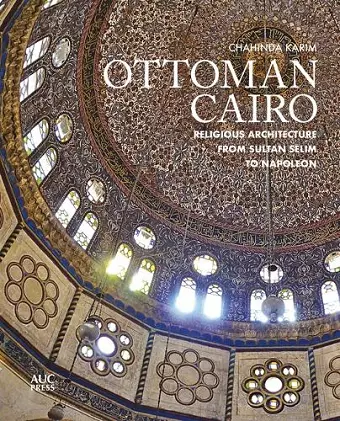Ottoman Cairo
Religious Architecture from Sultan Selim to Napoleon
Format:Hardback
Publisher:American University in Cairo Press
Published:7th Dec '21
Currently unavailable, our supplier has not provided us a restock date

A unique, richly illustrated study of Ottoman religious buildings standing today in Cairo
With the conquest in 1517 CE of Egypt by the Ottomans, Cairo lost its position as the capital of the Islamic empire to Istanbul but it retained an eminent position as the second most important city, with Egypt still regarded as one of the wealthiest provinces of the new empire. Round minarets with pointed hoods, as symbols of the new rulers, began filling the landscape alongside the octagonal minarets with pavilion tops of the Mamluks, new mosques, zawiyas, and madrasas/takiyas were built to emphasize the continuation of Sunni Islamic rule, while the use of tiles imported from Turkey introduced new decorative styles to the city’s existing rich carvings and marble paneling.
This book invites readers and students to revisit a long-overlooked era of Cairo’s architectural evolution, offering a unique, comprehensive study of Ottoman religious buildings still standing today. It provides detailed descriptions and walk-throughs of the buildings covered, visually, through its rich collection of plans, line drawings, and photographs, and through the narrative that infuses each image with life, shedding light on the continuous evolution of architecture in Cairo even after the city had ceased to be the capital of the Islamic empire.
“Chahinda Karim’s comprehensive and well-illustrated survey fills a generational gap in scholarship on Cairo’s Ottoman architecture and reminds us of the formidable power of this magnificent city to mold all stylistic influences into a formal and spatial character all its own.”—Nasser Rabbat, Massachusetts Institute of Technology
“With this meticulous study, Chahinda Karim at last fills a much-needed gap in Cairo’s architectural history, bringing us the glories of the city’s Ottoman architecture in clear and delightful form.”—Tarek Swelim, Hamad Bin Khalifa University, Qatar
“A welcome contribution to the history of Islamic architecture in Cairo and of architecture in the Ottoman Empire, this amply illustrated and accessible documentation of religious monuments from four centuries fills a gap in the literature and stimulates further interest in the field.”—Doris Behrens-Abouseif, SOAS, University of London
"This copiously illustrated volume explores the little-known religious buildings erected in Cairo during the three centuries before 1800 when Egypt was ruled from the Ottoman capital at Istanbul. Combining meticulous first-hand observation with extensive research in the historical sources and archival documents, Karim shows how patrons and builders adapted foreign ideas and forms to local styles and techniques to create dozens of buildings that contribute to Cairo’s unique architectural heritage."—Jonathan Bloom, Boston College
"Chahinda Karim is to be commended for bringing to light the architecture of an era poorly thought of and widely neglected. . . .This will be a welcome and useful starting point for all students who can visit the religious monuments of the Ottoman period."—Caroline Williams, ASTENE Bulletin
"This work challenges a common misconception among scholars that Ottoman religious architecture in Egypt, from the 16th to 18th century, represents a decline in skill and attractiveness from the architecture of the preceding Mamluk period. The book shows how Mamluk religious structures influenced the Ottoman newcomers and their search for a new local architectural identity."—AramcoWorld
ISBN: 9781649030849
Dimensions: unknown
Weight: unknown
256 pages